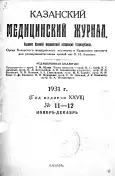A. Piney. "The latest achievements of hematology". State Ed. 1931 3 p. 75 K.
- Authors: Golyaev N.K.
- Issue: Vol 27, No 11-12 (1931)
- Pages: 1179-1182
- Section: Articles
- URL: https://journals.rcsi.science/kazanmedj/article/view/85117
- DOI: https://doi.org/10.17816/kazmj85117
- ID: 85117
Cite item
Full Text
Abstract
Most of us have little access to English literature. Therefore, it is necessary to welcome the desire of the State Publishing House to acquaint the reader with Piney's book, with his material and thoughts, with his references to literature, largely English. It is not intended to give guidance on hematology, in which—at least briefly-everything essential was reflected. Its purpose is to introduce the reader to some chapters and issues of hematology, apparently more interested in the author himself. Hence the large unevenness of lighting and the diversity of the material. Comparatively detailed II and n th deals with the inheriting issues: 1) the development of blood cells, 2) leukemia-leukemia. Piney considers all forms of leukemia to be neoplasms. The author's justification of such an understanding seems to me to be little convincing; in particular, the comparison of leukemic changes with changes in metastases of malignant neoplasms in the bone marrow seems to me based on a purely external and superficial similarity (I do not have other works in my hands, where the issues are covered in more detail). P i n e y understands his interpretation as a working hypothesis. 3) Pernicious anemia. According to the author, for the development of pernicious anemia, there must be: a) the remains of metalloblastic erythropoiesis in the liver (a constitutional feature) and b) that 4P or other irritant. "The disease is a pathological and clinical, but by no means an etiological unit" (69 p.). Piney expresses confidence that he has brought "some order to this somewhat chaotic question" (81 pages); to judge how much the author is right, I do not have enough familiarity with the factual material put by the author as the basis of his "working hypothesis". 4) Hemorrhagic diathesis. And here the author is mainly interested in pathogenesis, at the end of the chapter he tries to link various forms. 5) Of the 5 chapters devoted to splenomegaly, more space is given to Gaucher's disease and acholuric jaundice "as being of high theoretical interest."
Keywords
Full Text
##article.viewOnOriginalSite##About the authors
N. K. Golyaev
Author for correspondence.
Email: info@eco-vector.com
professor
Russian FederationReferences
Supplementary files





